It was precisely this reluctance I felt when Mova offered me the chance to test their P50 Pro Ultra. A relatively unknown brand on the European market that claims to offer all the premium features of a €1,500 robot… for less than €1,000? This price/technology equation intrigued me enough to shake me out of my usual skepticism.
After several weeks of coexisting with this little technological marvel, it’s clear that my vision of robot vacuums has radically changed. The P50 Pro Ultra has proven to be much more than just a gadget – it could well represent that pivotal moment when cleaning robots finally become what they promised to be from the beginning. Let's take a look at what changed my mind.
The Mova equation: when technical borrowing becomes an innovation strategy
A fascinating case study in the ultra-competitive robot vacuum ecosystem, Mova strikes a subtle balance between targeted innovation and strategic reuse. Without ever claiming a connection to Dreame Technology (a satellite of the Xiaomi ecosystem), the brand clearly leverages a familiar technical base to deploy a price-disruption strategy. This “technological cousinship” represents a particularly astute approach: why reinvent the wheel when you can optimize it and offer it at a lower price? The P50 Pro Ultra perfectly illustrates this philosophy by combining proven architecture and specific innovations like the anti-tangle “Clean Chop” system. This silent transfer of know-how allows Mova to avoid costly cycles of fundamental R&D while focusing its resources on the points of differentiation that really matter to the user. The resulting economic equation (proven technical foundations + targeted optimizations + reduced commercial margins) effectively shakes up the established oligopoly of premium robot vacuum cleaners. It remains to be seen whether this emerging strategy represents a simple transitional phase or the foundations of a new major player in our connected home ecosystem.
Design and construction: functional elegance
The robot: compact but sophisticated
First impression out of the box: the P50 Pro Ultra displays an impeccable finish. With its dimensions of 35 × 35 × 10.38 cm, it has a standard size for this type of device, although its height of 10.38 cm deserves to be highlighted – an extra centimeter can make the difference under certain low furniture. Its weight of 4 kg gives it good stability without making it difficult to handle.
The LiDAR turret on the top allows it to effectively map its environment, even in total darkness. The device has three touch buttons on the top for basic functions (start, return to base, localized cleaning). A fourth button hidden under the cover allows you to reset the device if necessary.
On the sensor side, the P50 Pro Ultra doesn't skimp on the equipment: two-line 3D laser sensor, intelligent RGB camera for obstacle identification, LED flash for dark environments, void sensors to prevent falls, and even a side sensor to optimize cleaning along walls. The whole thing demonstrates a careful design, thought out to maximize cleaning efficiency.
The charging base: thoughtful and practical design
The P50 Pro Ultra's docking station deserves special attention as it reflects Mova's design approach. With its controlled dimensions (42 × 47 × 45 cm), it blends harmoniously into the domestic space despite the impressive technicality it contains. I was particularly seduced by its refined aesthetic in glossy white which contrasts pleasantly with the often massive and austere stations on the market.
The intelligence of the design is evident in the elegant concealment of the clean water (4L) and dirty water (3.5L) tanks under a front panel with clean lines. This minimalist approach transforms what could have been a simple technical equipment into a decorative element that naturally harmonizes with a contemporary interior.
The 3.2L dust compartment, hidden behind a silver panel on the bottom, offers an impressive 75 days of battery life, according to the brand's specifications. A small, discreet side tank houses the detergent dedicated to the mop's self-cleaning system, completing this cohesive ensemble where each element finds its place without disturbing the visual harmony.
This successful integration of technicality and aesthetics demonstrates a design maturity that one would not necessarily expect to find in an emerging market challenger. The base of the P50 Pro Ultra is not simply a technical plinth – it constitutes a true design element that enriches the space in which it is placed.
Installation and start-up: apparent simplicity, some technical subtleties
The initial configuration of the P50 Pro Ultra demonstrates Mova's desire to make the user experience as seamless as possible. After strategically positioning the base and connecting its power cable (with the useful option of winding the excess cable around the back), the next step is to download the Mova Home app, available on iOS and Android.
The app is a barely disguised clone of the Dreame interface—a pragmatic choice that deserves to be praised rather than criticized. Why laboriously reinvent something that already works effectively? This strategic reuse ensures a mature user experience from the first launch.
The pairing process begins by scanning a QR code located on the top of the robot (under the hood) or on the quick start manual. Once this first step is completed, the app guides you step by step through the WiFi connection and pairing process, with clear voice messages confirming each step. Be careful, however: like many IoT devices, the P50 Pro Ultra is only compatible with 2.4 GHz WiFi networks, a limitation that can be surprising in this price range.
Finally, installation and firmware update. It was precisely during the firmware update stage that I encountered an unexpected pitfall: after a progress bar stuck at 25% for nearly 3 minutes, I had to force close the app and restart the process, this initial experience lacked the promised fluidity.
Once this incident was overcome, the initial mapping proved remarkably effective. On a simple open space test area of approximately 20 m², the robot completed its spatial modeling in just 40 seconds. For a full floor with multiple rooms, allow 3 to 5 minutes – a reasonable time considering the accuracy of the result. The LiDAR system provides an impressively accurate spatial representation, which the application then allows you to customize with appreciable granularity (merging/dividing rooms, virtual no-go zones, identifying floor types, etc.).
The automatic recognition of spatial segments proved surprisingly accurate, requiring only minor adjustments for certain transition zones. The interface also offers a 3D visualization of your space, a superfluous but visually satisfying feature that demonstrates the technical maturity of the legacy application.
Smart Features: A Brain in a Vacuum
Navigation and Obstacle Detection
The P50 Pro Ultra shines with its ability to intelligently navigate through space. Thanks to its LiDAR system coupled with an RGB camera, it effectively avoids most obstacles. In my tests with various objects (shoes, cables, toys), it generally managed to navigate around them accurately.
Particularly impressive: its ability to identify the type of obstacle it encountered. The app shows you a photo of the avoided object with a label (shoe, cable, animal, etc.).
Of course, it's not perfect. It occasionally ran over a backpack strap and a cable on a second pass. But overall, obstacle detection is superior to what I've seen on other models in this price range.
Adapts to different surfaces
Surface detection is another strong point. The robot automatically identifies carpets and increases its suction power accordingly. Above all, it raises its mops when it detects a carpet or rug, thus avoiding wetting them – although I noticed a slight residual moisture on some thick carpets.
Its “Flex Reach” technology is particularly innovative: the side brush and one of the mops can extend up to 4 cm to the side to reach corners and follow baseboards with unprecedented efficiency. This is a real plus for areas usually neglected by standard robot vacuum cleaners.
Clean Genius and dirt detection
The “Clean Genius” mode allows the robot to automatically adjust its cleaning strategy according to the level of dirt detected. A sensor analyzes the color of the dirty water as it returns to the base and, if it is particularly cloudy, the robot automatically returns to clean the problem area.
This function proved quite effective during my tests with dried coffee or mud stains. The robot clearly identified areas requiring several passes and returned to them without any intervention from me.
Suction performance: power and intelligence tested for everyday use
Power measured against the canine challenge
With its advertised 19,000 Pa of suction power, the P50 Pro Ultra is firmly at the top of the current technological spectrum. This impressive figure translates into particularly convincing observable performance.
I personally awaited this robot with impatience tinged with skepticism on this precise point. Living with Ella, my adorable Brittany Spaniel whose existential mission seems to be to cover my home with a constantly renewed layer of fur, constitutes a stress test for any vacuum system. This dog clearly has a knack for strategically distributing fur—under furniture, in inaccessible corners, and mysteriously concentrated on my black clothes. A talent I would have preferred her to develop to bring back croissants or close the door behind her.
I could only note its impeccable efficiency. The robot demonstrates a remarkable ability to capture different types of debris on hard floors, whether fine particles or larger waste. Everyday kitchen stains, various dust particles and especially that ubiquitous dog fur generally disappear on the first pass, without requiring several cleaning cycles. A small revolution in my daily life as a pet owner perpetually armed with an adhesive roller.
Anti-hair technology: finally a viable solution
The “Clean Chop” technology integrated into the main brush is probably the most relevant innovation for homes with pets. Its active hair cutting system effectively prevents the formation of tangles, which are traditionally the weak point of robot vacuums.
After several weeks of intensive use in an environment that Ella strives to transform into a miniature replica of the savannah during shedding season, the brush has remained remarkably clean. No more weekly detangling sessions where I clumsily tried to extract tangled clumps of hair with a mixture of scissors and creative swearing. The cutting mechanism effectively intercepts and cuts hairs before they can form those famous “Gordian knots” that usually end up blocking the rotation of the brush.
Multi-surface adaptability
The adaptive intelligence of the P50 Pro Ultra is particularly evident during transitions between different surfaces. The robot automatically detects rugs and carpets, instantly increasing its suction power to compensate for the increased resistance of the fibers. This dynamic modulation simultaneously optimizes cleaning efficiency and battery life.
Even more impressively, the robot intelligently manages the constraints of mopping during these transitions. When confronted with a carpet while operating in combined vacuum-mop mode, the P50 Pro Ultra automatically returns to its base to leave its mops there before tackling soft surfaces. This automated orchestration eliminates the need to manually create complex exclusion zones in the app – a feature that is particularly valuable in mixed interiors where hard and soft floors coexist.
This contextual adaptability, coupled with its substantial suction power, allows the P50 Pro Ultra to maintain consistent performance across the entire home space, regardless of the diversity of surfaces encountered. A versatility that constitutes one of the major assets of this model in a technological ecosystem where specialization often prevails over flexibility.
In this daily fight against the inexorable spread of canine fur, I have finally found a technological ally up to the challenge. Ella seems slightly disconcerted by this unexpected development in our triangular relationship with house dust – but she will adapt, probably by developing new hair distribution strategies. The arms race continues.
Floor Washing: Beyond Wetting
Washing Efficiency
The P50 Pro Ultra's dual-rotating mop washing system is part of the current trend for premium robot vacuums. On fresh dirt (splashes, footprints), performance is excellent with almost total removal from the first pass. When faced with older or ingrained stains (dried coffee, traces of mud), the results remain satisfactory (around 70-80% removal) but sometimes require several passes or additional manual intervention – a limitation inherent to all robots in this category, regardless of their price.
What really sets the P50 Pro Ultra apart is its particularly competitive performance/price ratio. It offers cleaning capabilities comparable to established models in the premium segment, but at a significantly lower price.
The robot's ability to modulate the water flow according to the type of floor is particularly appreciable: less water on parquet, more on tiles. The mops exert enough pressure to scrub effectively, unlike some models that simply drag a damp cloth.
One small drawback: when cleaning with water, I noticed that the robot did not always follow the edges as precisely as in vacuum mode alone, sometimes avoiding imaginary obstacles. Nothing catastrophic, but it's something that could be improved in a future update.
Household Crash Test: Put to the Extreme
To test the P50 Pro Ultra's real-life limits, I orchestrated a disaster scenario: several large clumps of hair, a generous amount of granulated sugar, and to top it all off, a substantial splash of barbecue sauce—the perfect trinity of household disaster.
Results after a standard first pass:
- Sugar: 100% removed (efficiently vacuumed)
- Hair: about 95% removed (some hairs remaining in the seams of the tiles)
- Barbecue sauce: 90% removed, but partially spread over a larger area than initially
Faced with this encouraging but improvable result, I used the app's "additional cleaning zone" function to specifically target the problem area. The robot automatically returned to its base to clean its soiled mops before returning to specifically tackle the marked area. After two additional passes in "Deep" mode (with maximum water flow), even the most stubborn traces of barbecue sauce had completely disappeared, as well as the stubborn hairs.
While the Genius feature didn't automatically identify the need to return, this ability to intelligently manage exceptional situations, adapting its cleaning strategy and refreshing its tools mid-mission, demonstrates the sophistication of the P50 Pro Ultra's app - particularly valuable for homes with a high potential for domestic chaos.
The intelligence of regularity 🔄
The true power of this type of device lies in its ability to maintain a consistent level of cleanliness through regular, scheduled interventions. It is precisely in this preventative maintenance philosophy that the P50 Pro Ultra excels.
Before the P50 Pro Ultra, I used a mop-type vacuum cleaner. In fact, it's more effective, but also because I manually target the areas where the marks are stubborn and I go over them several times. Here, it's the one that has to analyze and understand. It does this very well in 80% of cases.
Personally, I've established a routine that has transformed my relationship with housekeeping: a daily cleaning in standard mode during the week (scheduled during my office hours), supplemented by a deep cycle on Sundays when I'm out walking Ella – my little dog and official co-producer of household clutter. This silent orchestration guarantees a constantly clean floor without the slightest intervention on my part.
Self-cleaning system
The real highlight of the P50 Pro Ultra lies in its self-cleaning system. At the end of the cycle, the mops are automatically washed in hot water (75°C) in the base, with the addition of the specific Mova detergent. The base even has a sensor that analyzes the turbidity of the dirty water to determine if a second wash cycle is necessary.
After this wash, the mops are dried in hot air (45°C) for about 3 hours. I measured the temperature during this process and indeed, it fluctuates between 47 and 50°C. The result: perfectly clean and dry mops, ready for the next use, without unpleasant odors.
The base's wash plate is also self-cleaning, which prevents the accumulation of dirt and bacteria. This is a real plus compared to other models whose docking stations quickly become breeding grounds for germs.
Ultimately, it’s not so much the raw cleaning power that makes the P50 Pro Ultra valuable, but its ability to intelligently integrate into your home ecosystem to maintain a high standard of cleanliness without the associated mental burden.
The Mova Home app: comprehensive and intuitive
The Mova Home app stands out for its rich functionality and clear interface. You will find:
- A real-time visualization of the robot's path
- A display of detected obstacles with photos
- The ability to customize the map (up to 4 floors can be saved)
- Exhaustive cleaning options: 4 modes (vacuum/mop/combined/sequential), 5 suction levels, 32 water flow levels
- The “Clean Genius” mode for fully automated cleaning
- A customizable weekly schedule per room
- A detailed cleaning history
The application also offers advanced settings such as charging during off-peak hours, do not disturb mode, or even child lock.
I particularly appreciated the ability to create cleaning sequences (for example: first the kitchen, then the living room) and to set different water levels depending on the room.
Autonomy and noise level: endurance silent
The P50 Pro Ultra's battery life is simply impressive. Equipped with a 5200 mAh battery, it can theoretically clean up to 1100 m² on a single charge in standard mode. In my tests, even in maximum suction mode, the battery life remains exceptional.
The robot automatically returns to its base when its battery reaches a critical level, partially recharges, and then resumes exactly where it left off. A full charge takes about 3.5 hours, and my measurements confirmed that it recovered about 68% in 2 hours.
In terms of noise, the P50 Pro Ultra is rather discreet compared to the competition:
- Silent mode: 53 dB
- Standard mode: 56 dB
- Turbo mode: 58 dB
- Max mode: 65 dB
- Max+ mode: 67 dB
The automatic emptying of the dust bin is louder (74 dB) but only lasts 10 seconds. Mop washing fluctuates between 47 and 70 dB, while drying is particularly discreet at only 37 dB.
Daily maintenance: minimalist
Maintenance of the P50 Pro Ultra is limited to the essentials:
- Fill the clean water tank when necessary
- Empty the dirty water tank regularly
- Change the dust bag every 2-3 months (depending on use)
- Occasionally clean the sensors with a soft cloth
Since the mops and dust bin are automatically emptied and cleaned, human intervention is minimal. It's probably one of the most autonomous robot vacuum cleaners I've tested so far.
The small flaws that persist
Despite all its qualities, the P50 Pro Ultra is not without its flaws:
- Excessive height: at 10.38 cm, it doesn't fit under certain low furniture. I would have liked to see Mova reposition the microphones elsewhere than on the laser turret to gain a few millimeters.
- Improvable obstacle detection: although generally effective, it sometimes mistook coffee beans for animal droppings, and ran over some cables during a second pass.
- Residual moisture on carpets: despite lifting the mops, some carpets remained slightly damp after its passage.
- Longevity of spare parts: no replacement accessories are provided in the box, you have to buy everything separately.
- Absence of rubber strip on the bumper: a small detail, but one that would have been appreciated to cushion the rare contacts with furniture.

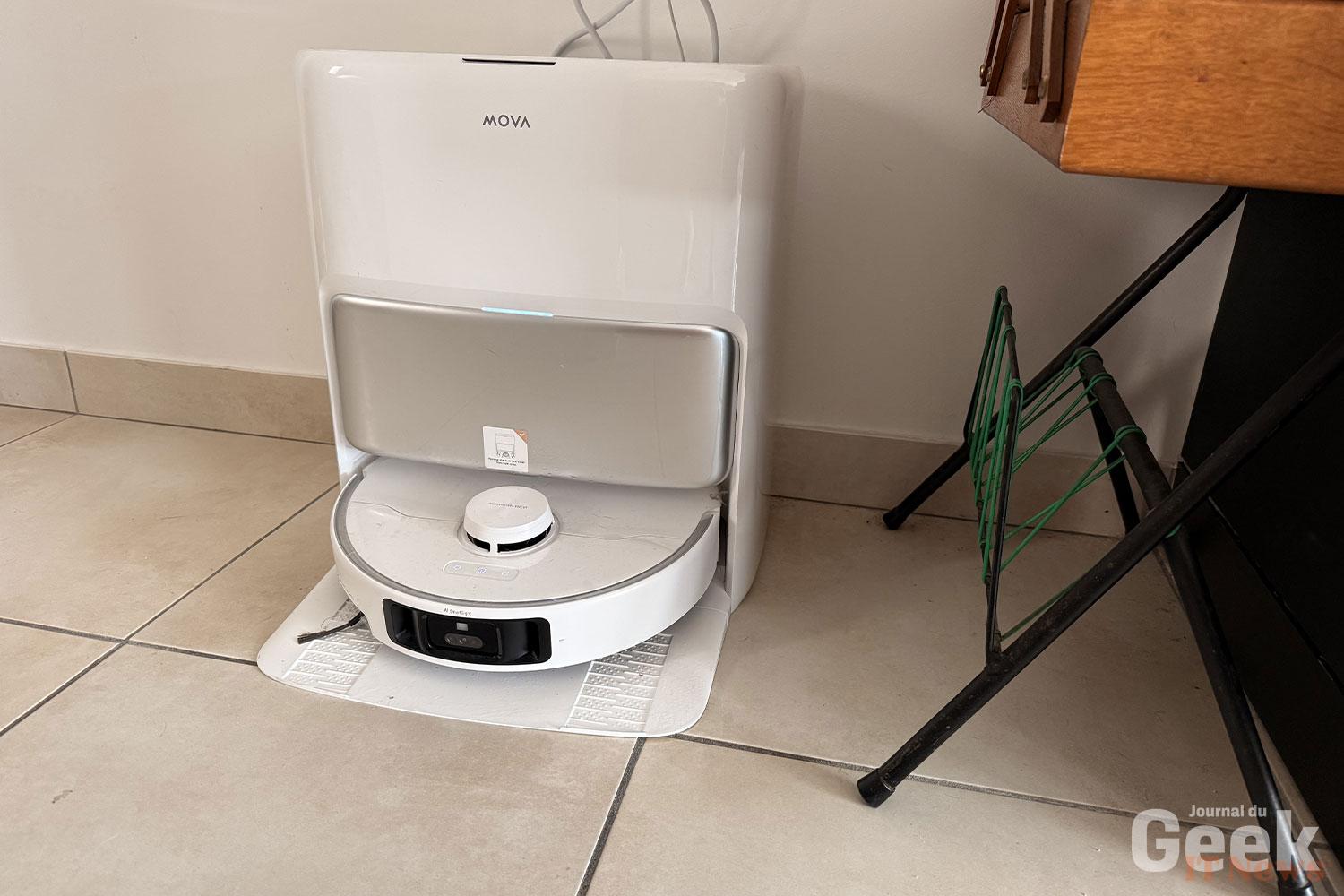
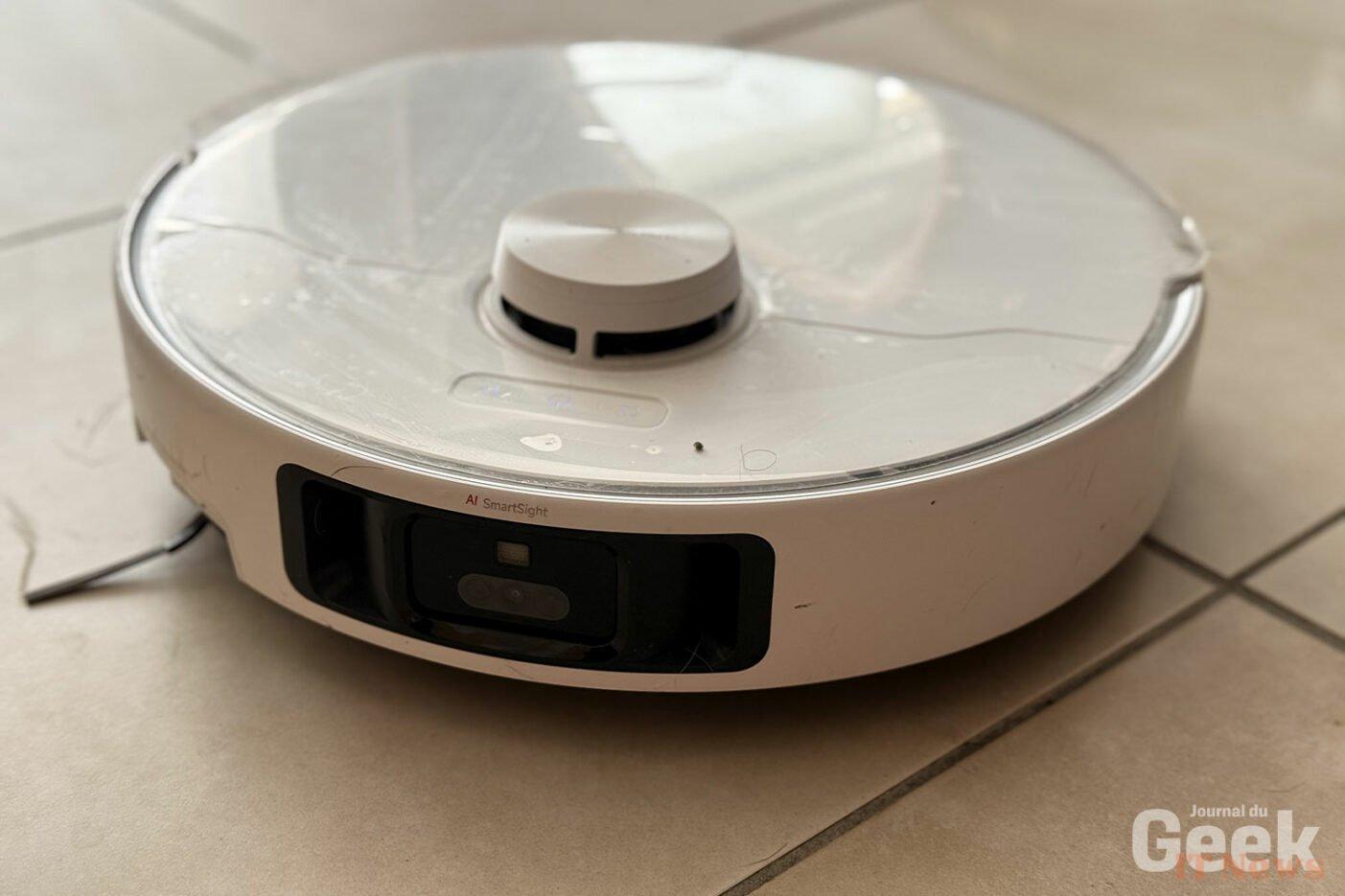
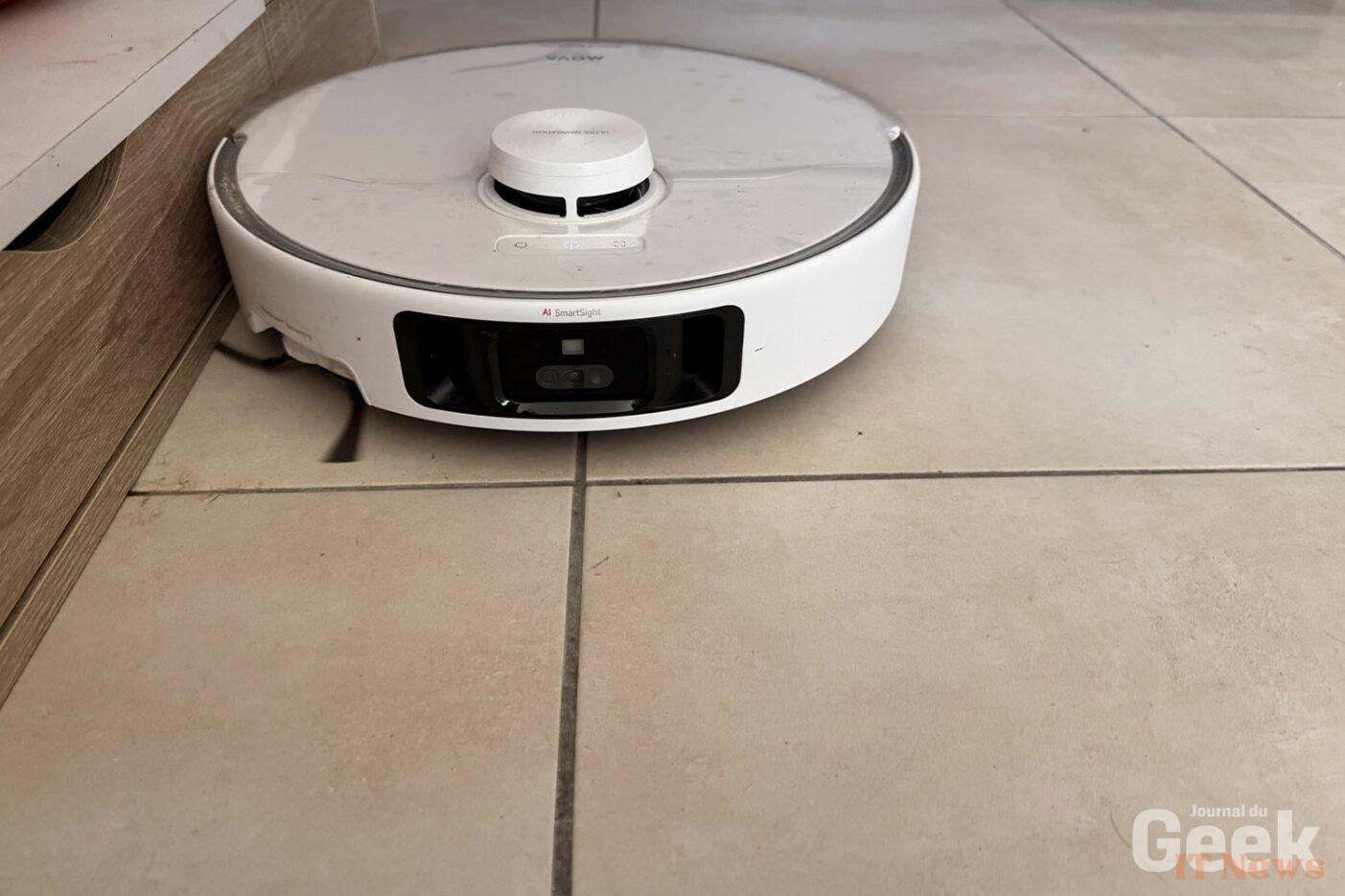

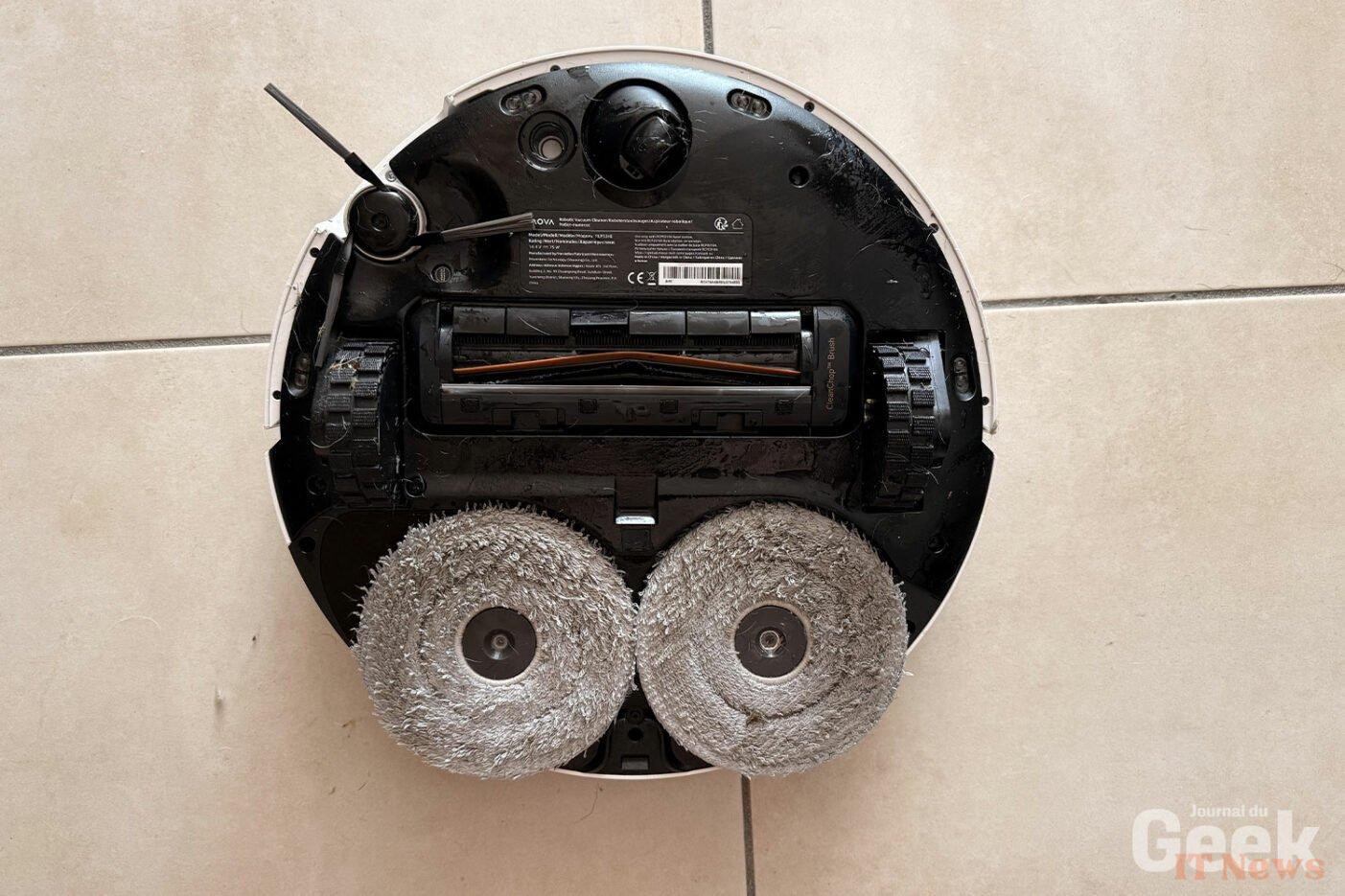

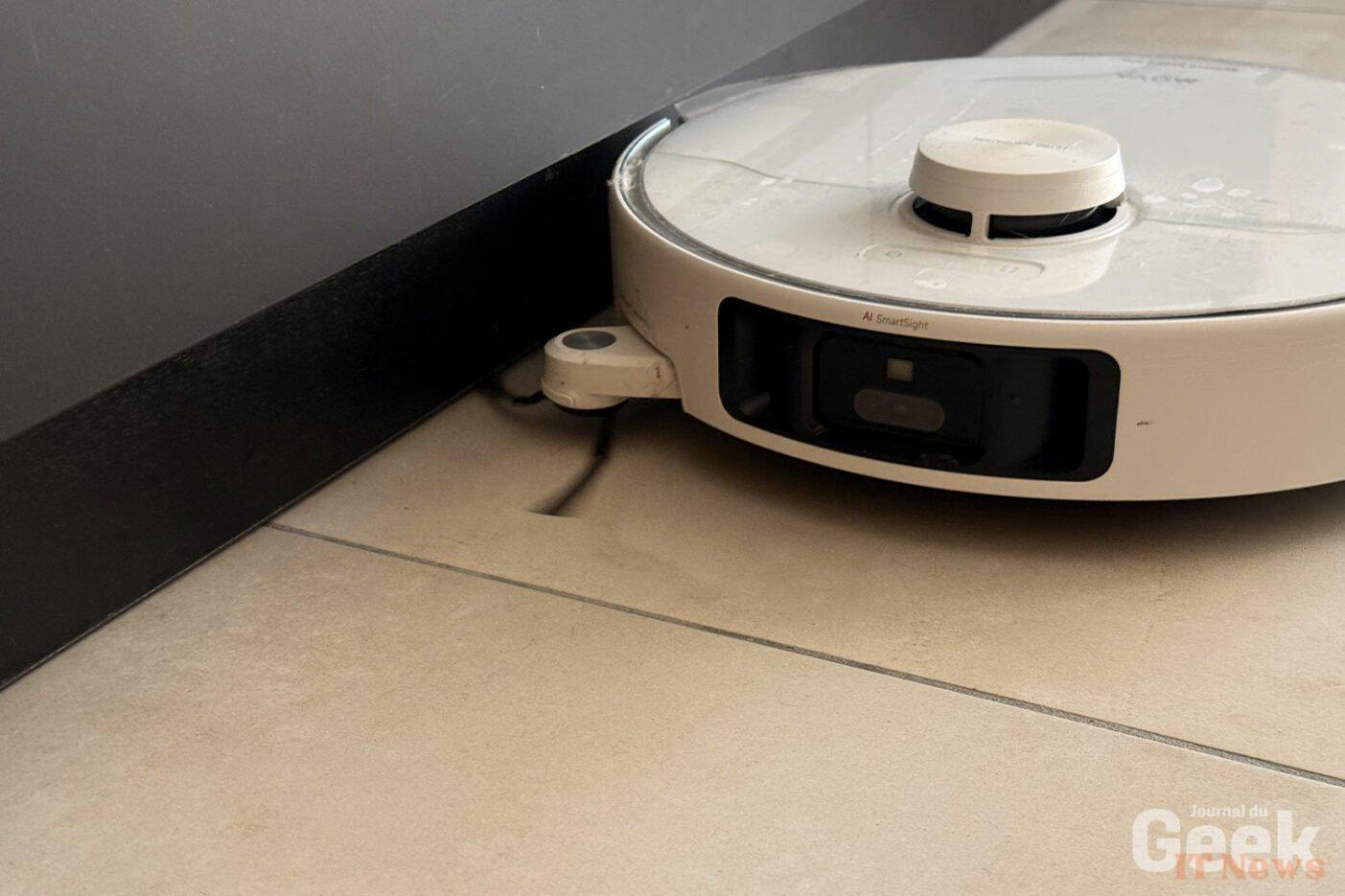

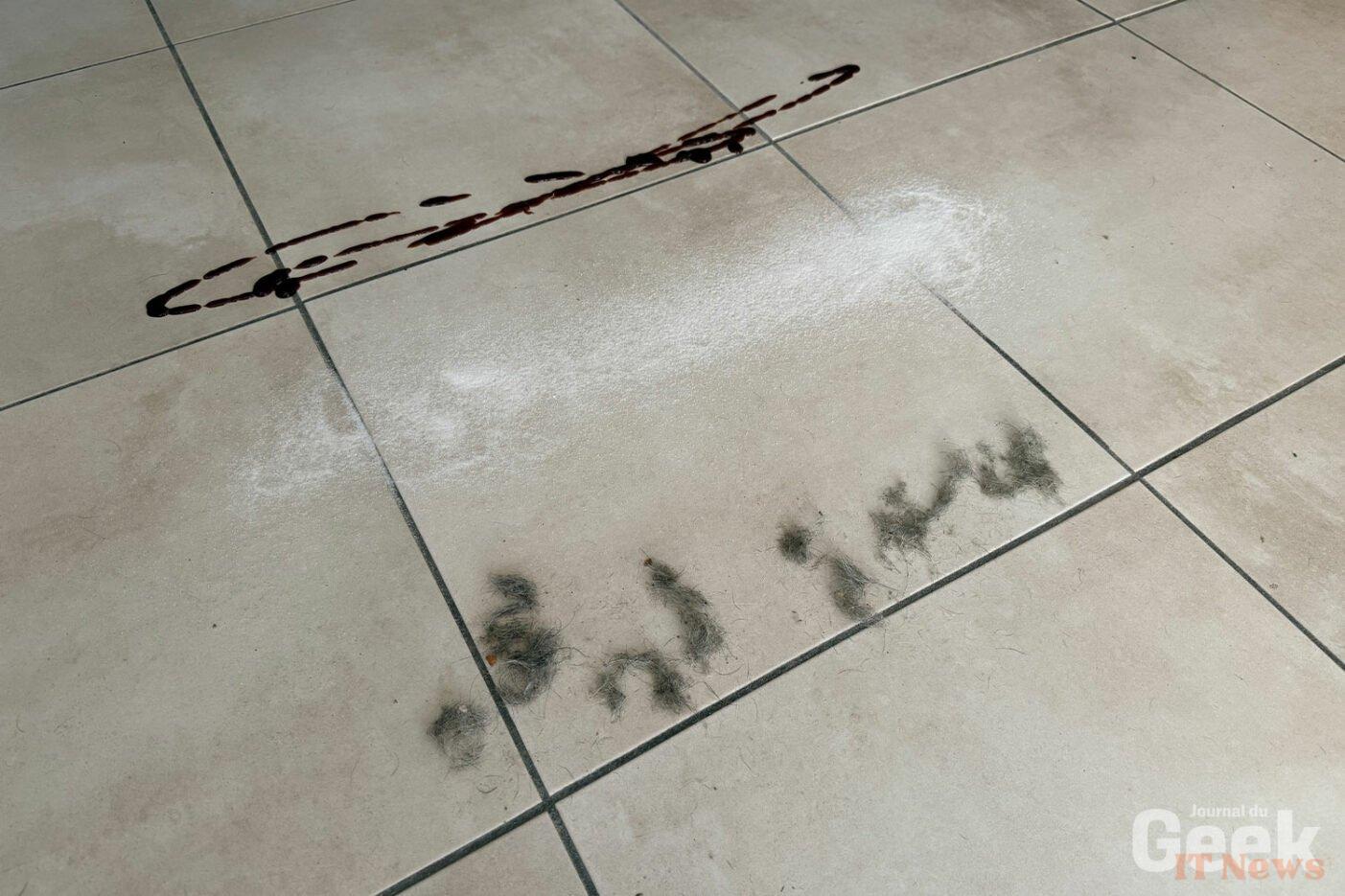

0 Comments